Bangla Script
Bangla Script The modern Bangla alphabet has undergone a long evolution. A large number of ancient epigraphic records and manuscripts have been discovered from different parts of Bengal, which have supplied important information to reconstruct the historical origin and development of the modern Bangla alphabet. But before we go into detail of its historical origin, it needs to give a brief description of the ancient Indian Brahmi script, the parent script of the modern Bangla alphabet.
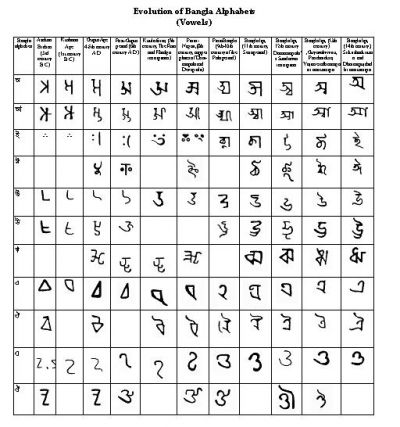
By virtue of the direction of writing, ancient Indian scripts are divided mainly into two parts, the Brahmi and the Kharoshthi. The Kharosthi was written from the right to the left, while the Brahmi left to the right. The ancient Indians took the Kharosthi alphabet from the Aramaic script. But this script was mainly limited in the North-West frontier of India. It spread over other parts of India during the Kusana period. A number of Kusana coins, which have been discovered from Bengal, bear the Kharosthi script. Besides these, a number of terracotta seals and fragment potsherds have been discovered from Chandraketugarh and Bedachapa in West Bengal, which bear also the Kharoshthi alphabet. But the Kharoshthi alphabet has not made any contribution to the development of the Bangali alphabet.
The modern Bangla alphabet originated from the ancient Indian Brahmi script, which was the oldest and popular script of India. The discovery of the Indus valley writing has led some scholars to guess that Brahmi was locally developed out of the Indus valley writing system. But no one has been able to demonstrate how this evolution took place. Some scholars are of the view that it was borrowed from outside of India. But there is no definite proof about this assumption. Actually, it was a significant contribution of the ancient Indian people who invented Brahmi scripts and their own numerals. The Indians used to believe that the Brahmi originated from the creator Brahma and hence, this hence the script has been named Brahmi. On the other hand, it is assumed that as the Brahmi was the alphabet of the Brahman, it has been named as Brahmi. The most ancient written record of Brahmi was discovered on a vase at Piprahwa (487 BC), Tarai in Nepal. But Brahmi script had widely been incised in the stone pillars and stone slabs of the great Mauryan King Ashoka. We get the complete form of Brahmi in the Asokan rock edicts. In this connection, it may be imagined that the Brahmi made a long way of evolution to come to this form of Asokan stage. But it is interesting to note that in course of time the Indians had forgotten to read and write the Brahmi alphabet. It is stated that once Firuzshah Tughlaq, the sultan of Delhi, collected a pillar inscription of Asoka and called upon the scholars around him to decipher it. But nobody was able to do it. In 1837, James Prinsep, a British scholar, was able to read the Asokan Brahmi successfully, which paved the way for deciphering other ancient Indian Proto-regional Brahmi. Some epigraphic records of Bengal were deciphered during the last half of the 19th century. But a large number of the early Bengal inscriptions were deciphered and published within the first half of the 20th Century. On a close observation, the forms and variations of the alphabets of those huge epigraphic records of Bengal, it has been possible to trace the historical development of the Bangla alphabet. Bangla as well as other modern Indian alphabets such as Nagari, Sarada, Tamil, Telegu, Kanedi, Gujrati, Grantha, Gurumukhi, Malaya, Tibbeti are the present form of local development of the Brahmi alphabet. With the passage of time the writing style of Brahmi has been changed. The styles of changes of the writing forms are not the same in all places. As a result, the Brahmi alphabet took different shapes in the different regions of India. In course of time, the changing form of the Brahmi alphabet in Bengal had taken the shape of modern Bangla alphabet. Now an attempt may be made to focus the origin and development of the Bangla alphabet by a systematic paleographic study of the early Bengal epigraphic records.
The modern Bangali alphabet was derived from the Northern class of Brahmi script. But in course of time the Northern class of Brahmi had turned into two separate branches, the Eastern variety and the Western variety.
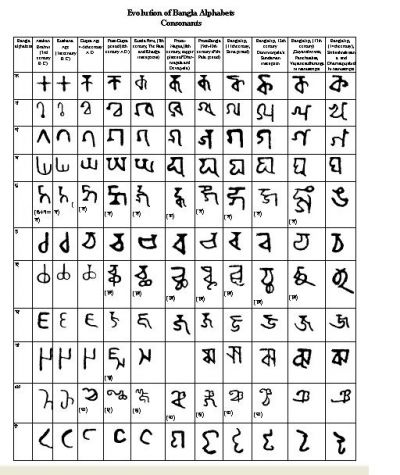
Mahasthan Brahmi inscription is considered to be the most ancient written object in Bengal. But more developed form of the Brahmi scripts appeared to this inscription than those of the Asokan edicts. Now it is presumed by the paleographers as the late Mauryian Brahmi. Another stone image inscription, which was found at Shilua in noakhali district, bears Brahmi alphabets. But the inscription of the image is badly corroded and there is hardly any scope to detect the shapes of the alphabets. 'Besides these, there are some terracotta plaques of Mahasthan and Palashhbari in bogra district, some seals and potsherds of Chandraketugarh and Bedachapa in West Bengal also bear ancient Brahmi script. But these objects bear an obvious sign of the developed form of the Brahmi inscriptions, which was incised probably within the second and third century BC.
The Sunga alphabet and the script of the Northern Kshatrapas show further development of the Brahmi in Northern India in the first century BC. The next stage in its development is exhibited in the Kushana inscriptions. At this stage, most of the Brahmi inscriptions remained unchanged but a small number of alphabets took a cursive form in place of Asokan angular form. A remarkable change took place at this stage in writing medial 'a' (অ), which took a slanting form instead of the Asokan horizontal shape.
The Gupta Age is mainly the starting point of the evolution of the Bengali alphabets. The mighty Guptas of Magadha gradually captured the whole of North-Eastern India and established political integrity and stability near about two centuries after the fall of the Kushana Empire. During their rule, the Sanskrit occupied the position of an official language in lieu of Prakrit. Sanskrit language and literature highly flourished during the Gupta rule in Bengal. Simultaneously, the writing style forms and materials developed this time. Palmyra leaves or bark sheets were widely used for writing literary works. But they were perishable writing materials. So, the royal charters or land grants were incised on durable copper plate for the purpose of making it long lasting. The change of the writing materials made stylistic difference in writing the Brahmi scripts. Eight full lengths Gupta copper plates were found in North Bengal and another plate was discovered from Comilla District in Bengal. These discoveries facilitated the determination of the type specimens of the Eastern alphabet in each particular period. Consequently, it has become possible to trace the development of the Bangali alphabet from these records alone. Cursive forms were widely used in writing alphabets during the Gupta rule in Bengal. In shushunia Rock style firmly angular lines were used but in the Gupta copper plates of Bengal an increasing tendency of the use of curve angles became prominent. But it is interesting to note that three dots type 'i' (ই) changed its form in the Gupta copper plates. In the changed form two dots were placed on the left of a vertical. The base of the medial 'u' curved downward which was the birth of modern Bangla 'u' (উ). At the same time we observe that in place of slanting Kushana medial system, the medial a, i, e, changed into cursive forms.
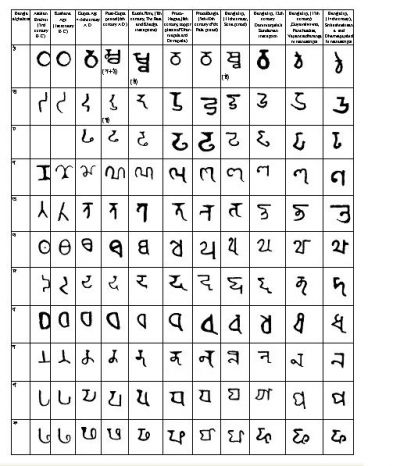
Most of the consonants changed a lot during the Gupta rule. 'Ka' has the curved mid-bar instead of equal arms, while 'gha' maintains the straight base. The left limbs of 'Kha', 'ga' and 'sa' (স) are longer than the right. The alphabet 'ca' changed with a rounded beak instead of triangular or semi-triangular loop. The alphabet 'ja' has its lower armed slightly bent at the tip but it clearly indicates the initial stage of Bangla 'ja'. The 'jna' has already developed as a cursive form. 'Ta' flattens its top, while 'da' has its back slightly rounded. The letter 'na" is of the open-mouthed with a loop at the left place of horizontal Brahmi shape, while the alphabet 'tha' is oval with a mid line instead of Brahmi dot system. 'Pa' and 'pha' have round left angles, while 'va' optionally has a slight bent at the left arm. 'Ma' has two varieties. First one has a tail turning to base slopes to the right vertical, while the second is constricted in such a form which the base curves upward and replaces the right vertical. 'Ya' is seen to the tripartite Brahmi form but a loop appears at the left arm. The dental 'sa' is found with a loop at the left. 'La' and 'ha' are turning into a hooked type shape and they are being found very cursively drawn, especially in the Baigram copper plate of Budhagupta. These changes of the alphabets during the Gupta period may be defined as the dawn of Bangla scripts.
The Gupta style has slightly changed in the Post-Gupta (6th century AD.) copper plates. The change is also observed in the copper plates of Dharmaditya, Gopacandra and Samacharadeva. At this stage, North-Western alphabet is being gradually displaced from Eastern India and the Eastern variety is coming into certain new features. First, the reference of the development of the alphabet 'a' may be made. The alphabet 'a' appears with comma like curve at the left end while its lower curve extends further and the middle bar slopes to the right. It clearly suggests that the initial stage of Bangla 'a'. The downward curve of the letter 'u' has extended from the left end of the vertical, which clearly shows the development of Bangla 'u'. The triangular 'e' (এ) still has its base at the bottom. Only in the Ghugrahati plate the base is seen on the top. The medial 'u' in 'tu' (তু) is turned down, but in 'gu' (গু), 'du' (দু) and 'bhu' (ভু) it is turned up.
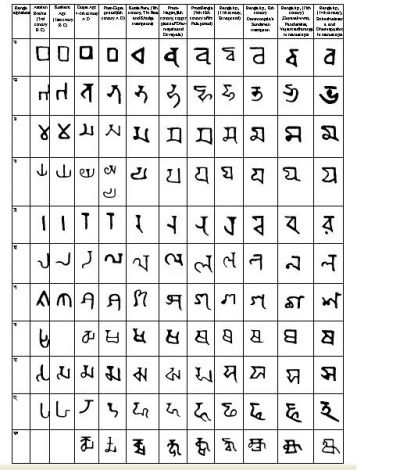
'Kha' is turning into a flat-topped and its lower part is taking into a triangular shape, which clearly indicates the initial stage of Bangla 'Kha'. 'Na' (ণ) drops the loop at the left of the open mouthed form. `Tha' maintains the oval form in the copper plate of Dharmaditya, but the bulge form is served in the plate of Samacharadeva. But a radical change has been made in writing the letter 'Ya' (য). The tripartite 'ya' of the Gupta Age has been changed to bipartite form in the copper plate of Samacharadeva. This 'ya' clearly shows the development of the Bangla 'ya' (য). On the other hand, the hooked form of 'la' and 'ha' are being much developed in the Post-Gupta age, which is turning to Bangla form.
The epigraphic records of the 7th century may mark another important stage of the development of the Bangla alphabets. Many new features are seen in writing alphabets during this period. The script of this time is recognized as the Kutila (bent type) form, which is derived from the middle Ganges valley. The main characteristics of the alphabets of this period are bent arm, solid triangle, acute angle, head mark and tailed form. The 'Kutila' form appears first in the Nidhanpur copper plate of Vaskaravarman, the Tippera copper plate of Lokanatha, the Kalapur copper plate of Marundanatha, and in the Kailan copper plate of Sridharana Rata. Subsequently, more developed 'Kutila' form is observed in the copper plate of the Devakhadga and Balabhatta.
The letter form of 'a' is curved-type but it develops an Eastern variety by sloping the middle bar and lengthening the right vertical which is quite close to modern Bangla 'a'. The alphabet 'i' takes a different shape as it is observed two dots and tailed below. The medial 'i' 'e' (এ) and the alphabet 'u' are changing into more curved shape.
The consonant 'Ka' is changing radically. It adopts the looped variety and a triangle form which seems quite similar to the modern Bangla 'Ka'. The alphabet 'tha' and 'dha' (ধ) show a definitely bulging body than those of the previous types. 'Da' (দ) is, as usual, the double curve type but a tick appears at the lower curve. Similarly 'ta' (ট) develops tick at the end of the flat-top. The alphabets 'pa', 'pha' and 'ma'- all have the acute angle at the right. 'Ra' has changed radically which takes a triangular foot-mark in place of only a vertical arm. Both 'la' and 'ha' have the firm bases and develop their hooks in a downward curve. The change of the alphabets during the 7th century put valuable contribution to develop the 'Proto-Bangla' alphabet in the next stage.
A significant variation is observed in writing the alphabet in Bengal with the rise of the Palas in 8th century AD. The Palas captured a large tract of lands of North-Eastern India and kept it under their control for about four centuries. During this period art, language and literature flourished which caused the development in the writing style. At the beginning of the Pala rule in Bengal, certain new features in writing alphabets developed due to the impact of the Nagari scripts of Northern India. Then the alphabet of Bengal turns into a new shape which is called 'Proto-Nagari'. This type of scripts widely appear in the Khalimpur copper plate of Dharmapala, the Munger copper plate of Devapala and the Saranatha inscription of Mahipala-I.
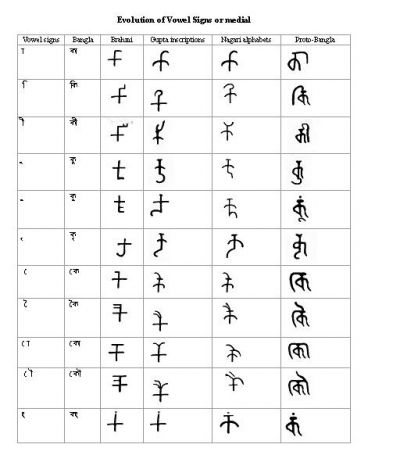
But the 'Proto-Nagari' scripts did not last long in Bengal. With the influence of local 'Kutila' style, it gradually turned into certain new features which were defined by RD Banerji as 'Proto-Bangla', while PL Paul defined this as 'immediate precursor of the modern Bengali alphabet'. The 'Proto-Bangla' alphabet has widely been used in the copper plate inscriptions of the early medieval Bengal, especially during the second half of the 9th century and the whole of the 10th century AD. This type of alphabets first appeared in the Bangard inscription of Mahipala I, the Badal pillar inscription of Narayanpala and the Amgachi copper plate of Vigrahapala. 'Proto-Bangla' alphabet is elaborately incised in the Chandra, Sena, Varman and the later Deva copper plates. During these regimes, many alphabets took complete Bangla form while the others seem to be closed to the modern Bangla alphabets. The medial develops at this stage with the ornamental curve akin to modern Bangla letters. But it is to be noted that the alphabet 'cha' has dramatically been changed as its left loop has placed to the right like the modern Bangla 'cha'. Many conjunct letters developed at this stage akin to modern Bangla form.
The 'Proto-Bangla' scripts turned into Bangla form during the 11th and 12th century AD. The Bangla alphabets for the first time were widely observed in the Anulia copper plate of laksmanasena and the Sahitya Parisad copper plate of Visvarupasena. The Sundarban copper plate of Dommonpala (1196 AD) was incised mainly in complete Bangla form of scripts. The Muslim conquest of Bengal in c. 1204 AD halted the development of the Bangla alphabets for the time being. Since then, no copper plate was issued in Bengal. Therefore, it is possible to trace the further development of the Bangla alphabets from the manuscripts onward. The Laghukalacakratika and the kalacakravatara, the two manuscripts of the 13th century AD in the collection of the Royal Asiatic Society of Bengal were obviously written in Bengali hand. The manuscript Pancaraksa (c.1289 AD) in the collection of the university library at Cambridge also bears complete form of the Bangla alphabet. More developed form of the Bangla alphabets are observed in the manuscripts Guhyavalivivrti and the Vajranesadhanangani.
The Bangali language and literature was revived at the rise of the independent sultans of Bengal (1335-1535 AD). During this stage, under the influence of shrichaitanyadeva's Vaisnavism the six Goswamins, 64 Mohantas and many other Vaisnavas wrote a large number of books in which complete Bengla form of alphabets were widely used. More developed form of Bangla scripts have been observed in the Chandidas's Krisna Kirttan. Two inscriptions are found in the Ganesa Temple at Begunia in Burdwan District (second half of the 15th century AD) in which more developed Bangla scripts have been seen. No significant change appeared to the manuscripts of the 16th to 18th century AD. In 1778, the Bangla letters became stereotyped with the introduction of the printing press. Charles Wilkins established the first Bangla printing press at Hughli with letters modeled after the hand written letters used in old Bangla manuscripts. A Grammar of the Bengali language by Nathaniel Brassey Halhed was the first Bangla printed book. The introduction of printing put an end to the variation of the Bangla scripts and it assumed its present form. Current technology has provided various fronts for Bangla scripts but its basic form has remained unchanged.
The Bangla alphabet consists of both vowels and consonants. There are eleven vowels and 39 consonants in the Bangali scripts. The vowels can be pronounced independently but the consonants need the support of vowels to be pronounced. Unlike English, the Bangla vowels are not always written in full, being replaced by their signs. The vowel 'a' (অ) is considered to be a part of every consonant and it has no particular sign. However, other vowels usually appear in their complete forms at the beginning of any word but they represent their signs thereafter. It is stated that the Indians imitated this system from the Semitic and the Aramaic form of writing.
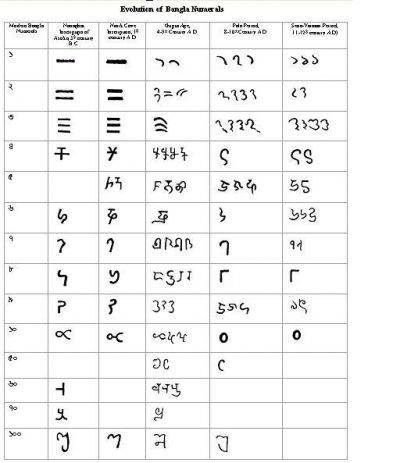
Now an attempt may be made to discuss the origin and development of the Bangla numerals. The Arabs are generally credited to be the innovator of mathematical science or the knowledge of arithmetic and the numerals are distinguished by the symbols termed Arabic. But the idea that the numerals are Arabic in origin is not an old one. The Medieval and the Renaissance writers recognized them as Indian origin. Al-khowarezmi, a man of great learning and one to whom that the world is much indebted for its present knowledge of Algebra and Arithmetic, distinctly stated that the numerals were of Hindu Origin. The Arab writers defined the numerals as 'ilm-hindi' (Indian Science). Actually the nine-unit figure and a zero, arranged to a decimal order are apparently indigenous in India but it has not been possible yet to know how and when it originated. It is stated that the numerals are more ancient than the invention of writings. The peoples of Rigveda were introduced with the numerals. Seven rivers (sapta-Sindhu), thousand of mans (sahasra-purusa), eight peaks (astau-parvata), three heaven (trista-svarga) such numeral words have been mentioned in the Rigveda.
The next use of numerals is found in the Nana Ghat inscription of Asoka, supposed to date from the early part of the third century BC. We notice the further development of the numerals in the Nasik cave inscription during the first century of the Christian era. The Nagari numerals have been derived from the Gupta inscription in Northern India. But in Bengal, the numeral figures first appeared in the Gupta copper plates for the writing of the Gupta samvata (Gupta Era). Certain new features in writing numeral figures appeared in the Pala inscriptions. The copper plate inscriptions of the Palas refer only numerals to report the 'regnal' year of the ruling kings. But all the numeral figures are not found in these records. We get some further idea about numerals to the subsequent copper plates, especially the Sena, Varman and the Later Deva copper plates, and manuscripts of these periods. The numerals of the copper plates and in the manuscripts of the Sena period seem to be akin to the modern Bangla numerals. But it is difficult to trace the development exactly at this stage on the basis of the meagerly references in the contemporary historical records.
From the aforesaid references, it may be concluded that the Bangla scripts are the final stage of its gradual development from the Brahmi alphabet in Eastern India. Although the Bangla alphabets originated from the Brahmi scripts, now it is not possible to trace the similarities with the Brahmi scripts. With the passage of time the Brahmi scripts took different shapes in different hands of innumerable writers in Bengal region and finally it assumed the present form. The ornamental medial of the Bangla alphabet is completely the indigenous origin of Bengal. The alphabets of Nepal and Assam have been derived from the Bangla scripts. At present, the modern Bangla alphabet is very popular with the Bangla speaking people of independent Bangladesh, West Bengal and Tippera of India. The Bangla scripts are very dear to the Bangla speaking people like their mother language. [Shariful Islam]
Bibliography RD Banerji, The Origin of the Bengali Scripts, University of Calcutta, 1917; GH Ojha, Bharatiya Prachina Lipimala (Hindi), India;' JG Buhler, Indian Paleography, English Translation by' JF Fleet, published as an appendix to the Indian Antiquary, 1904; AH Dani, Indian Paleography, Clarendon Press, Oxford, 1963; SN Chakravarty, Development of the Bengali Alphabet from the Fifth Century AD to the End of the Muhammadan Rule, Journal of the Royal Asiatic Society of Bengal, Letters Vol. IV, 1938;' PL Paul, The development of the Bangali Script, Indian Historical Quarterly, June 1936.'
